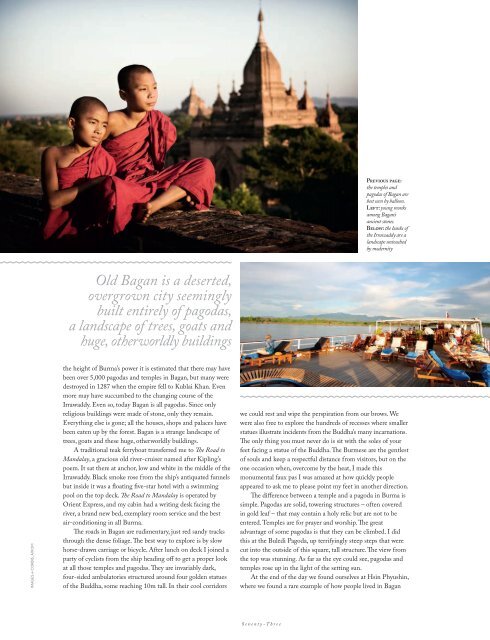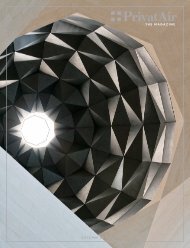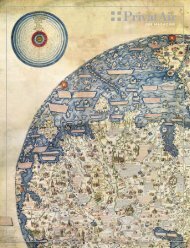january-2012
january-2012
january-2012
Create successful ePaper yourself
Turn your PDF publications into a flip-book with our unique Google optimized e-Paper software.
IMAGES©CORBISAXIOM<br />
Old Bagan is a deserted,<br />
overgrown city seemingly<br />
built entirely of pagodas,<br />
a landscape of trees, goats and<br />
huge, otherworldly buildings<br />
the height of Burma’s power it is estimated that there may have<br />
been over 5,000 pagodas and temples in Bagan, but many were<br />
destroyed in 1287 when the empire fell to Kublai Khan. Even<br />
more may have succumbed to the changing course of the<br />
Irrawaddy. Even so, today Bagan is all pagodas. Since only<br />
religious buildings were made of stone, only they remain.<br />
Everything else is gone; all the houses, shops and palaces have<br />
been eaten up by the forest. Bagan is a strange landscape of<br />
trees, goats and these huge, otherworldly buildings.<br />
A traditional teak ferryboat transferred me to Th e Road to<br />
Mandalay, a gracious old river-cruiser named after Kipling’s<br />
poem. It sat there at anchor, low and white in the middle of the<br />
Irrawaddy. Black smoke rose from the ship’s antiquated funnels<br />
but inside it was a fl oating fi ve-star hotel with a swimming<br />
pool on the top deck. Th e Road to Mandalay is operated by<br />
Orient Express, and my cabin had a writing desk facing the<br />
river, a brand new bed, exemplary room service and the best<br />
air-conditioning in all Burma.<br />
Th e roads in Bagan are rudimentary, just red sandy tracks<br />
through the dense foliage. Th e best way to explore is by slow<br />
horse-drawn carriage or bicycle. After lunch on deck I joined a<br />
party of cyclists from the ship heading off to get a proper look<br />
at all those temples and pagodas. Th ey are invariably dark,<br />
four-sided ambulatories structured around four golden statues<br />
of the Buddha, some reaching 10m tall. In their cool corridors<br />
we could rest and wipe the perspiration from our brows. We<br />
were also free to explore the hundreds of recesses where smaller<br />
statues illustrate incidents from the Buddha’s many incarnations.<br />
Th e only thing you must never do is sit with the soles of your<br />
feet facing a statue of the Buddha. Th e Burmese are the gentlest<br />
of souls and keep a respectful distance from visitors, but on the<br />
one occasion when, overcome by the heat, I made this<br />
monumental faux pas I was amazed at how quickly people<br />
appeared to ask me to please point my feet in another direction.<br />
Th e diff erence between a temple and a pagoda in Burma is<br />
simple. Pagodas are solid, towering structures – often covered<br />
in gold leaf – that may contain a holy relic but are not to be<br />
entered. Temples are for prayer and worship. Th e great<br />
advantage of some pagodas is that they can be climbed. I did<br />
this at the Buledi Pagoda, up terrifyingly steep steps that were<br />
cut into the outside of this square, tall structure. Th e view from<br />
the top was stunning. As far as the eye could see, pagodas and<br />
temples rose up in the light of the setting sun.<br />
At the end of the day we found ourselves at Hsin Phyushin,<br />
where we found a rare example of how people lived in Bagan<br />
Seventy-Three<br />
Previous page:<br />
the temples and<br />
pagodas of Bagan are<br />
best seen by balloon.<br />
Left: young monks<br />
among Bagan’s<br />
ancient stones.<br />
Below: the banks of<br />
the Irrawaddy are a<br />
landscape untouched<br />
by modernity






